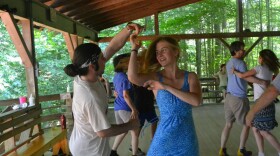Musician Nicole Singer, the organizer of Youth Traditional Song Weekend, which took place online this month due to the pandemic, is trying to bring young people and non-traditional audiences into folk music. WSHU’s Davis Dunavin brings us her story as part of Off The Path’s “Folk Songs” series.
Nicole Singer’s been playing folk music since she was a kid. And she has bona fide credentials as a singer of sea shanties. For one thing — she’s actually worked and sung shanties — on a real ship.
“I took a year off between college and grad school to work aboard Mystic Whaler,” she said.
The Mystic Whaler was what’s called a tall ship — it’s got three big sails and wooden masts, and it looks like it just sailed out of history. But it actually sailed out of New London, Connecticut. The ship traveled along the Atlantic coast and the Hudson River, and it was often used for educational programs. Nicole started as a crew member and an educator.
“On a lot of these boats, you’re kind of doing both all the time. Like, you’re very much a sailor and a teacher at the same time,” she said. “I was living in the foc'sle, the tiny room, like way way way up at the bow of the boat. It was really hard work, physically hard and emotionally sometimes very hard. Really long days. It’s a very sun-up to sundown kind of job. I played a lot of music with whoever was onboard.”
Nicole still plays a lot of music. She’s an organizer for the New England Folk Festival, and she co-founded her own festival — called Youth Traditional Song Weekend. The idea is to encourage new and young audiences to get into folk music, which often skews toward older crowds.
“I think a lot of the time when we think of folk music, for so long we’ve thought of people of a specific generation who were part of the folk revival of the ’60s and ’70s, who were young adults then,” she said. “That perception is correct in many ways, but now also there’s younger generations coming in. I think it’s just, what do we picture when we picture the folk music scene? And that scene has been evolving rapidly. I think it’s really hard to be the only young person at a song session, and it’s made a little easier when you’ve got just one other person who’s in your age cohort there. There’s kind of a snowball effect when young people see there are other young people around. It makes it very appealing and powerful to stay and build community and friendships that way.”
Nicole said she’s had trouble being taken seriously in the sea shanty community — not just as a young person, but as a woman.
“So when I arrived on the shanty scene, I was one of very few people under the age of 40,” she said. “And I was one of very few women of any age. It was hard being young in that scene, and being a woman in that scene. When people are looking for a sound that sounds old to them, they’re imagining a grey-bearded dude singing these things. And that’s the authentic sound, right? There’s this big premium placed on authenticity. And of course the question is, what baseline of authenticity are you hearkening back to? Are you hearkening back to your notion of the 1800s sailor? Or are you hearkening to your notion of the sailor sailing in 2009 or 10? Because that was me.”
The whole scene changed last year when sea shanties hit big on TikTok, a social media platform popular among young people. More young people, women and people of color have been drawn to sea shanties.
Singer wanted to encourage her community to welcome them.
“I wrote a whole piece on this,” she said. “I wrote a big Facebook post on this that got shared very widely among sea shanty communities on the internet. And you know what, let me actually pull that up, hang on one second …”
I ask her to read it for me.
“Hey, fellow sea music nerds. This is kind of a long post, here goes. I really do think it’s possible to be welcoming and inclusive to people who are new to this music. New sea shanty enthusiasts want to learn.”
The whole post is pretty long — and Nicole covers a lot of ground. But this was the message that stood out most for me.
“We tend to hold tight to singing practices that we’ve fought and worked for, but that doesn’t mean that those practices can't evolve if we want and need them to,” she said. “We can keep the good things that make/have made our social singing traditions powerful and important, and also change what needs changing, especially if we want to see new people join in.”
The response within the sea shanty community was overwhelmingly positive. Nicole says there’s no hard data, but she and her contemporaries have seen a lot more young people, people of color, and LGBTQ+ people at folk music shows and festivals in the past 10 years. And she says the traditional parts of the community have gotten more accepting at the same time — if slowly.






